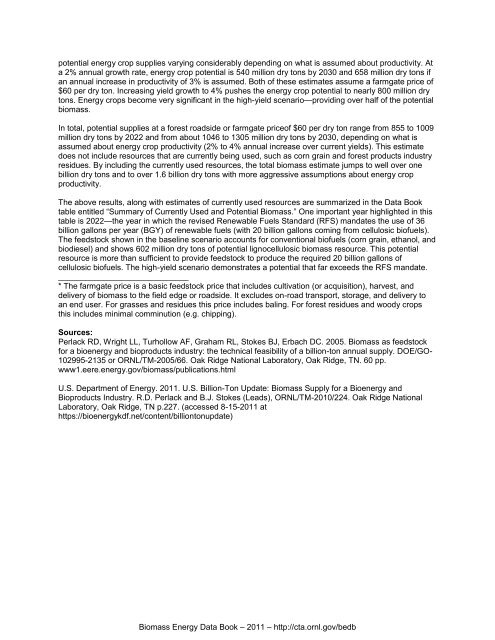Biomass Energy Data Book: Edition 4 - Full Document - Center for ...
Biomass Energy Data Book: Edition 4 - Full Document - Center for ...
Biomass Energy Data Book: Edition 4 - Full Document - Center for ...
You also want an ePaper? Increase the reach of your titles
YUMPU automatically turns print PDFs into web optimized ePapers that Google loves.
potential energy crop supplies varying considerably depending on what is assumed about productivity. At<br />
a 2% annual growth rate, energy crop potential is 540 million dry tons by 2030 and 658 million dry tons if<br />
an annual increase in productivity of 3% is assumed. Both of these estimates assume a farmgate price of<br />
$60 per dry ton. Increasing yield growth to 4% pushes the energy crop potential to nearly 800 million dry<br />
tons. <strong>Energy</strong> crops become very significant in the high-yield scenario—providing over half of the potential<br />
biomass.<br />
In total, potential supplies at a <strong>for</strong>est roadside or farmgate priceof $60 per dry ton range from 855 to 1009<br />
million dry tons by 2022 and from about 1046 to 1305 million dry tons by 2030, depending on what is<br />
assumed about energy crop productivity (2% to 4% annual increase over current yields). This estimate<br />
does not include resources that are currently being used, such as corn grain and <strong>for</strong>est products industry<br />
residues. By including the currently used resources, the total biomass estimate jumps to well over one<br />
billion dry tons and to over 1.6 billion dry tons with more aggressive assumptions about energy crop<br />
productivity.<br />
The above results, along with estimates of currently used resources are summarized in the <strong>Data</strong> <strong>Book</strong><br />
table entitled “Summary of Currently Used and Potential <strong>Biomass</strong>.” One important year highlighted in this<br />
table is 2022—the year in which the revised Renewable Fuels Standard (RFS) mandates the use of 36<br />
billion gallons per year (BGY) of renewable fuels (with 20 billion gallons coming from cellulosic biofuels).<br />
The feedstock shown in the baseline scenario accounts <strong>for</strong> conventional biofuels (corn grain, ethanol, and<br />
biodiesel) and shows 602 million dry tons of potential lignocellulosic biomass resource. This potential<br />
resource is more than sufficient to provide feedstock to produce the required 20 billion gallons of<br />
cellulosic biofuels. The high-yield scenario demonstrates a potential that far exceeds the RFS mandate.<br />
_____________________________<br />
* The farmgate price is a basic feedstock price that includes cultivation (or acquisition), harvest, and<br />
delivery of biomass to the field edge or roadside. It excludes on-road transport, storage, and delivery to<br />
an end user. For grasses and residues this price includes baling. For <strong>for</strong>est residues and woody crops<br />
this includes minimal comminution (e.g. chipping).<br />
Sources:<br />
Perlack RD, Wright LL, Turhollow AF, Graham RL, Stokes BJ, Erbach DC. 2005. <strong>Biomass</strong> as feedstock<br />
<strong>for</strong> a bioenergy and bioproducts industry: the technical feasibility of a billion-ton annual supply. DOE/GO-<br />
102995-2135 or ORNL/TM-2005/66. Oak Ridge National Laboratory, Oak Ridge, TN. 60 pp.<br />
www1.eere.energy.gov/biomass/publications.html<br />
U.S. Department of <strong>Energy</strong>. 2011. U.S. Billion-Ton Update: <strong>Biomass</strong> Supply <strong>for</strong> a Bioenergy and<br />
Bioproducts Industry. R.D. Perlack and B.J. Stokes (Leads), ORNL/TM-2010/224. Oak Ridge National<br />
Laboratory, Oak Ridge, TN p.227. (accessed 8-15-2011 at<br />
https://bioenergykdf.net/content/billiontonupdate)<br />
<strong>Biomass</strong> <strong>Energy</strong> <strong>Data</strong> <strong>Book</strong> – 2011 – http://cta.ornl.gov/bedb
















